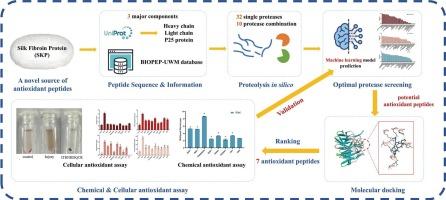从丝素蛋白中揭示新的抗氧化肽:一项集成的硅和体外研究
IF 9.8
1区 农林科学
Q1 CHEMISTRY, APPLIED
引用次数: 0
摘要
抗氧化肽能有效缓解氧化应激,在抗击退行性疾病方面具有巨大潜力。在这项研究中,我们开发了一种用于筛选抗氧化肽的机器学习模型,马修斯相关系数达到 0.892 ± 0.033,超过了最先进的(SOTA)模型。通过硅学筛选,确定了七种来源于丝纤维蛋白(SFP)的新型抗氧化多肽(即DEDY、NEEY、GAGRGY、ITRNHDQCR、VDHNL、QGDY和DDY),并随后进行了合成。其中,除 GAGRGY 和 QGDY 外,其他七种抗氧化肽在 ABTS 自由基实验中均表现出显著的抗氧化活性,是谷胱甘肽抗氧化活性的 1.26-3.25 倍。所有七种抗氧化肽都能有效保护红细胞免受氧化损伤。这种保护能力可能归功于它们结合自由基和调节 Keap1-Nrf2 通路的能力。总之,这项研究提出了一种从SFP中发现抗氧化肽的有效策略,并为测试机器学习模型的有效性提供了有力的实验验证。本文章由计算机程序翻译,如有差异,请以英文原文为准。


Unveiling novel antioxidant peptides from silk fibroin proteins: An integrated in silico and in vitro study
Antioxidant peptides exhibit significant potential in combating degenerative diseases by effectively mitigating oxidative stress. In this study, we developed a machine-learning model for screening antioxidant peptides, achieving a Matthews correlation coefficient of 0.892 ± 0.033 and surpassing the state-of-the-art (SOTA) models. Through in silico screening, seven novel antioxidant peptides derived from silk fibroin proteins (SFP) were identified (i.e., DEDY, NEEY, GAGRGY, ITRNHDQCR, VDHNL, QGDY, and DDY) and subsequently synthesized. Among them, all except for GAGRGY and QGDY demonstrated notable antioxidant activity in ABTS free radical assays, which were 1.26–3.25 times higher than that of glutathione. All seven antioxidant peptides effectively protected erythrocytes from oxidative damage. This protective capacity is likely attributed to their ability to bind free radicals and regulate the Keap1-Nrf2 pathway. Overall, this study presents an effective strategy for discovering antioxidant peptides from SFP and provides strong experimental validation for testing the effectiveness of the machine learning model.
求助全文
通过发布文献求助,成功后即可免费获取论文全文。
去求助
来源期刊

Food Chemistry
工程技术-食品科技
CiteScore
16.30
自引率
10.20%
发文量
3130
审稿时长
122 days
期刊介绍:
Food Chemistry publishes original research papers dealing with the advancement of the chemistry and biochemistry of foods or the analytical methods/ approach used. All papers should focus on the novelty of the research carried out.
 求助内容:
求助内容: 应助结果提醒方式:
应助结果提醒方式:


